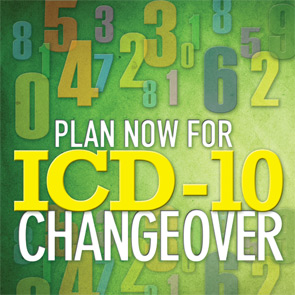
October 1, 2013 will mark a momentous, system-wide change for physicians in practices throughout the United States. That is the day the International Classification of Diseases, 10th Revision (ICD-10) code sets go into effect. Everyone covered by the Health Insurance Portability and Accountability Act (HIPAA)—not just those who see Medicare and Medicaid patients—will begin using the new code set.
“ICD-10 codes are more specific and therefore more numerous,” said Rudy Molina, MD, chair of the Insurance Subcommittee for the ACR. There were around 14,000 available codes under ICD-9; this will increase to 68,000 codes with ICD-10.
Moreover, the effects will be felt throughout the practice. “The change will impact the person greeting patients at the front desk, through the physicians, and all the way to the back office,” says Antanya Chung, CPC, CPC-1, CRHC, CCP, and director of practice management at the ACR. “Patient charts have to be updated, there will be changes to the superbill, physicians will document in greater detail, major changes will be made in computer systems, and there are probably going to be disruptions in practice as people are trained and new programs installed.”
Start with Working Groups
The first thing practices should do to prepare for the change is set up a working group to begin planning.
The group should look at current systems and work processes using ICD-9 codes. This includes clinical documentation, encounter forms/superbills, practice management systems, electronic health record systems, contracts, public health, and quality reports. Wherever ICD-9 codes appear, ICD-10 codes will take their place. Doing this focuses the transition group on what needs to change and the personnel involved making those changes happen.
“Identify as much educational and operational information as you can for free,” said Robert Tennant, MA, senior policy advisor for the Medical Group Management Association (MGMA) in Washington, D.C. “Use resources offered by the MGMA, ACR, AMA [American Medical Association], or any other group you belong to.”
In ICD-10, the level of specificity is much greater than in ICD-9. Many coders don’t have the knowledge of anatomy and physiology needed in the more clinically driven ICD-10.
—Deborah Grider, CPC
Look for Help
There are many places to go to get suggestions on how to best implement the changes needed. Most of the involved organizations are offering information on their websites for members and others (see “For More Information,” p. 34).
“The ACR will have extensive information available through the website, at the annual meeting, and in some major cities,” says Chung. “The American Medical Association has suggested timelines and budgets for members, as does the MGMA and the AAPC. The Centers for Medicare and Medicaid Services [CMS] is also a major provider of helpful hints.”
Speed Is of the Essence
“Many practices think this is just a software upgrade with no urgency in getting ready,” said Deborah Grider, CPC, CPC-H, CPC-I, CPC-P, CPMA, president and CEO of AAPC. “The ICD is used in many areas of the practice including financial, practice management, and electronic health records. Many think this is a 48–62-month transition, which means some are already way behind.”
Contact Vendors
An early contact every practice should make is with their information management vendors. “Practices need to be proactive in reaching out to their vendors,” Tennant says. “Get them on the record about when they will be providing updates to computer programs and when you can expect to begin testing. Nail down what it will cost so that budgeting can begin.”
